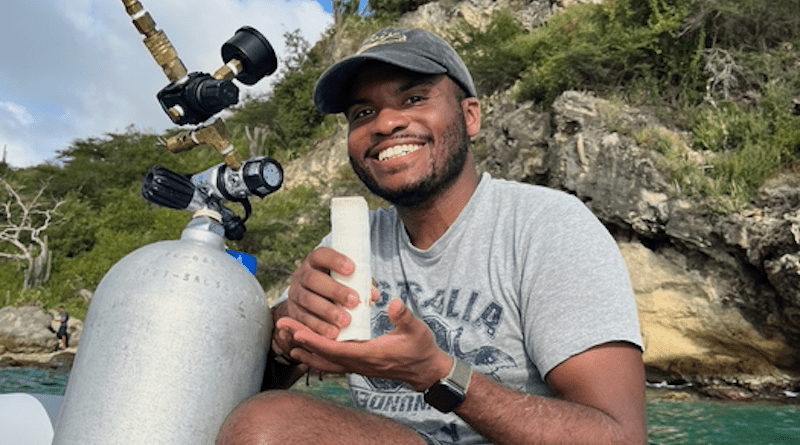Using Coral To Unravel History Of Slave Trade On St. Croix
Coral reefs are more than just a vital part of the ocean. They can also reveal clues about the past. Analyzing coral skeletons can paint a rich picture of the environmental history of an ecosystem, from temperature variability to land-use changes.
On the U.S. Virgin Island of St. Croix, the ruins of a Danish sugar plantation built from harvested coral bricks could be the key to understanding how and why the area was decimated by the 18th-century transatlantic slave trade.
With funding from the National Geographic Society, researchers at the Georgia Institute of Technology and the University of California, Los Angeles (UCLA) will travel to St. Croix to analyze this coral. They hope to determine how coral mining, dredging, and reef erosion affected near-shore biodiversity, contemporary coral populations, and bathymetry or underwater depth. The project uniquely combines archeology and oceanography.
“We can survey these corals to try and reconstruct the climate around St. Croix before, during, and after the slave trade — particularly with regard to sea surface temperature and trade wind strength,” said Isaiah Bolden, a co-principal investigator and assistant professor in the School of Earth and Atmospheric Sciences at Georgia Tech. “This could give us an interesting, climatically informed perspective on the timing of the transatlantic slave trade and why and how St. Croix became a part of this history.”
The Coral Codex
The first phases of the project involve collecting coral. Justin Dunnavant, co-PI, National Geographic Explorer, and assistant professor of archeology at UCLA, will use 3D photogrammetry, the process of combining photographs at different angles to create a 3D rendering, to determine which coral species were used in plantation construction. Then the researchers will collect live and historic coral samples with minimally invasive techniques so Bolden can analyze their composition.
Coral skeletons are a rich source of historical data. Like trees, living coral grows in annual rings and can be dated by counting these rings. For the dating of ancient samples, the team is also applying uranium-thorium dating, a type of radiometric dating that relies on a natural “clock” that forms as radioactive uranium locked inside of coral skeletons naturally decays into thorium.
Determining the ages of the plantation structures will help reveal whether the coral was harvested from the sea floor alive or if these buildings were constructed from preexisting coral rubble. Additional analyses can uncover clues of how the ecosystem has responded to direct human impacts from the 18th century to present. To this end, the project will also sequence proteins trapped in the skeletons of fossilized and contemporary corals on St. Croix to investigate genetic differences.
The coral skeletons can reveal more than age and genetic differences, though. Mineral “impurities” that get substituted into the growth bands of the limestone-like calcium carbonate skeleton of corals can be measured and used to infer sea surface temperature, salinity, pH, runoff, and many other environmental conditions during a coral’s lifetime.
“Corals try to build a pristine skeleton made of calcium and carbonate ions,” Bolden said. “The problem is seawater isn’t just a pure mixture of those two components, so some of this other stuff gets in the way. For example, the element strontium, which has a similar chemical behavior to calcium, is incorporated into the skeleton at a faster rate during cooler temperatures than warmer temperatures. This means we can use the ratio of strontium-to-calcium across growth bands in the coral skeleton as a clue toward past temperatures.”
Making these measurements involves drilling and dissolving powders from the coral growth bands and then using a mass spectrometer to analyze the chemical composition of the powders. The data, in turn, can be combined with instrumental records from the modern era to develop equations that translate the chemical changes into environmental changes.
“This is a really cool opportunity to study how local reefs have recorded and responded to climatic and anthropogenic changes during a definingly dark period of colonization and human civilization,” Bolden said. “How can we interface these new ecological and climate records with the written historical record to further detail the story of colonization and the slave trade in St. Croix?”
The St. Croix Ecosystem — Then and Now
The researchers will also collect contemporary data to build a better understanding of St. Croix’s existing modern coral reef ecosystems. They will collect and analyze seawater samples and conduct coral species and coverage surveys to capture current seasonal conditions and trends in reef health.
Throughout the project, the researchers will collaborate with local St. Croix universities and high schools to ensure the research isn’t just about the community, but also benefits it by giving students research opportunities.
“I’m really interested in this opportunity to bring a climate context to the history often taught in schools to discover things we haven’t learned,” Bolden said. “We’re talking about decolonizing geoscience and unearthing the stories that haven’t been told.”

